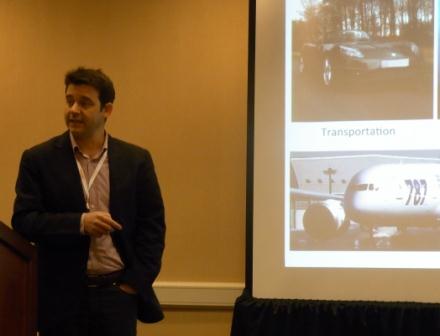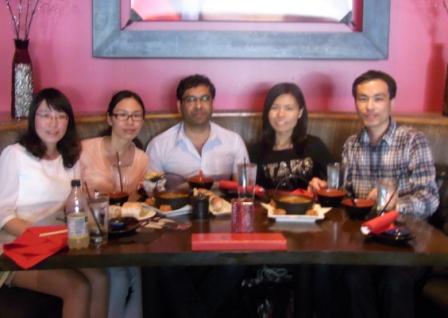With no programming at the PACRIM–GOMD conference on Wednesday afternoon, the only task was to discover the city of San Diego. After some shopping, Ling Fei (second from left) and her new friends enjoyed a Japanese dinner. Credit: Fei; ACerS.
As researchers, we know that it is difficult to find an individual material that perfectly fits its intended practical application. It is always important to make composite materials which complement each other as well give new properties. Usually composite materials offer better performance and significantly lower cost.

André Studart talks about his research on bioinspired composites, including their shape memory properties. Credit: Fei; ACerS.
This morning (Wednesday), André R. Studart from Switzerland gave an impressive talk on bioinspired complex materials. His group works on the microstructural design of bioinspired composite materials by manipulating the orientation and spatial distribution of stiff ceramic particles inside a continuous polymeric phase with the assistance of an applied magnetic field. To demonstrate this idea, he starts with a simple example in which nonmagnetic Al2O3 platelets were coated first with magnetite material. Once the coated platelets were dispersed in water under a magnetic field, the material immediately oriented vertically. When no field was applied, horizontal orientation was preferred. Modeling of the system shows that if the magnetic field is strong enough, it is going to overcome the gravity and thermal motion to favor orientation of the platelets with the field. They also found micrometer-sized materials are easier to manage because the behavior of nanomaterials is dominated by thermal randomization, and materials with size larger than the micrometer scale are strongly affected by gravity. What fascinated me most is they later replaced water with swellable polymer matrix as the continuous phase. Under this scenario, they can easily shape (e.g., bending, twisting) the solid materials and turn them back to their original shape as the polymer matrix swells or shrinks. To me, those are materials that will transform material science.
Another talk on porous ceramics given by a German scientist was also interesting and technically important. They introduced CO2 gas into extruded resin to get a foamed structure, which reminded me of how yeast produces pores in bread. With calcination at different temperatures, they were able to get different size distributions and mechanical properties, and even a core–shell structure. Because extruding technology is already in the market and able to process materials on a large scale, this method turns out to be very promising for commercial applications. Now, they are continuing their work with simulation to further understand of the principles. It is great that scientists never stop at functionality achieved; instead, they ask ‘why?’ and seek the underlying truth.
There were no lectures this afternoon, and the only ‘task’ assigned to ACerS was to discover the city. I went downtown with my new friends from this conference. There were a lot of PACRIM attendees on the bus, and one even joined us. Because none of them were from the United States, our destination, of course, was the shopping mall for gifts for friends or family. It is always nice to buy gifts for friends or family, because it is great to give and make those you care about feel loved. After shopping, we had a very nice Japanese dinner together. What is even nicer is to have dinner with so many new friends. It feels so good to learn more in science, as well as gain more friends!

